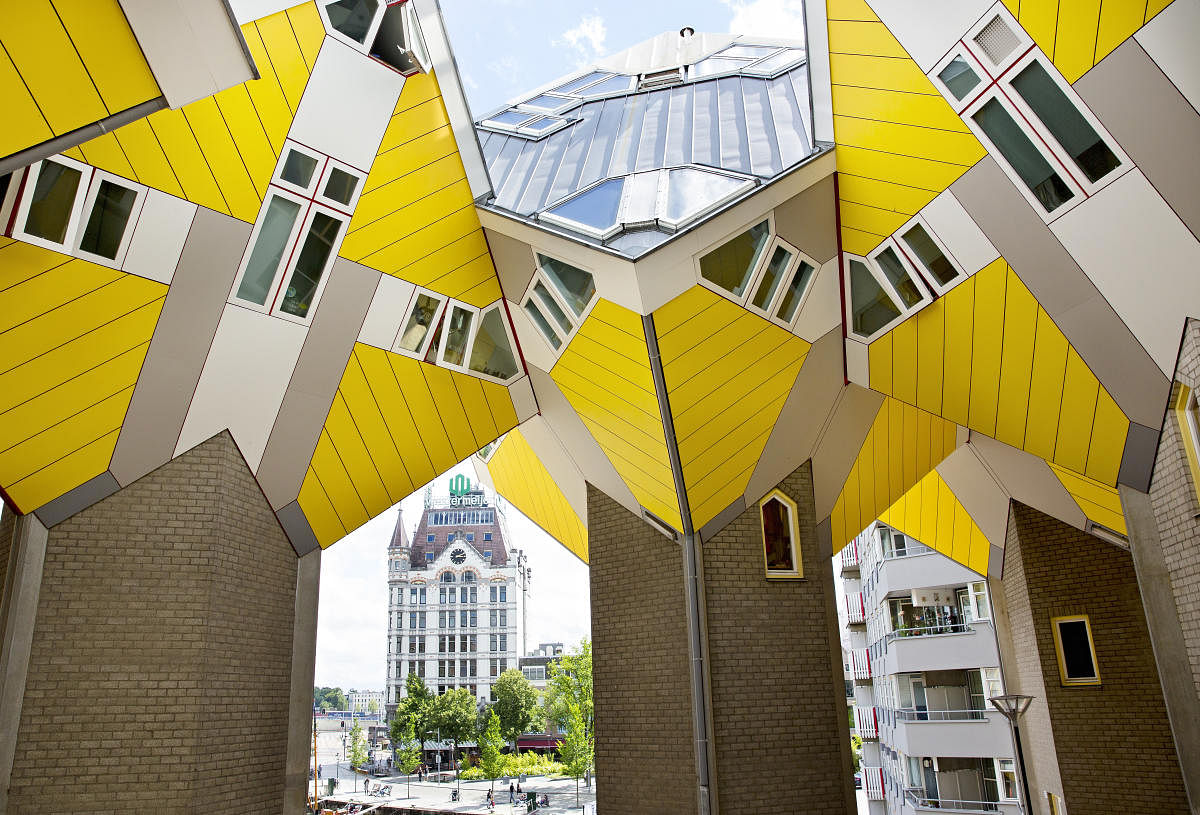
Shiny facades, funky architecture and quirky attractions beckon from everywhere I go in Rotterdam. Netherland’s second largest city, dubbed ‘Europe’s new capital of cool’ thrums with its own unique brand of creative energy.

Sustainable and thought-provoking buildings are ubiquitous, woven ceaselessly and seamlessly into the city’s architectural profile. Cutting-edge structures pepper downtown Rotterdam confetti.
The spectacular white-and-yellow Cube Houses rank as one of the city’s most iconic attractions. The asymmetrical houses that once had people living in them now stand transformed into popular AirBnbs. Designed by Dutch architect Piet Blom in the ‘70s, every unit is literally a cube tilting at 45 degrees with each triangular roof representing a treetop. Just across from the Cube Houses, I stroll into the Markthal. A covered bazaar and apartment complex, Holland’s largest indoor market was inaugurated in October 2014. Apartments arching above the 96 stalls hawk gastronomic treats — from Dutch cheeses to fresh fish, wines, honey, meats and confectionery. Beetroot-flavoured cheese anyone? Or saffron-infused honey? Friendly shopkeepers offer delicious samples I’m only too happy to accept.
As I look up, I’m gobsmacked by a spectacular ceiling splashed with Europe’s largest digital artwork. ‘Horn of Plenty’ by Dutch artist Arno Coene spans 13,000 square yards and depicts larger-than-life images of vibrantly coloured fruits, grains, and vegetables tumbling from the sky.
Open Air Museum
Art lovers don’t need to queue up at museums to view art in Rotterdam. Explore the city and it surfaces as a recurrent leitmotif. Pablo Picasso’s 46 ton ‘Sylvette’ sits at the intersection of Museumpark and Westersingel, part of a sculpture route that unfolds alongside Westersingel canal.
If street art is more your thing, check out Luchtsingel, a pedestrian bridge painted by local artists as a metaphor for building bridges among people. In a world fraught by protectionism and anti-migrant frenzy, there can hardly be a more appropriate symbol for tolerance.
“Plans are also afoot to develop floating houses to optimize living spaces in this city that has so many waterbodies,” the local guide informs me as we amble along Nieuwe Maas River, the pivot around which Rotterdam flows. A Floating Pavilion, at the Rijnhaven along the river, which already hosts MICE events, has set the template for such radical future developments.
Many cities take pride in designated quarters widely regarded as ‘cool’. But Rotterdam can claim, literally, to have a `Cool District’ abuzz with high street stores and restaurants. By 2020, redevelopment of ‘Coolsingel’, the broad street overlooking Rotterdam’s city hall will be complete whittling down traffic congestion and allowing for more space for pedestrians and cyclists.
No Planet B
Rotterdam’s concern to minimise its carbon footprint is impressive, a movement fuelled by committed entrepreneurs. Like the team from RotterZwam, which grows oyster mushrooms using coffee grinds from cafés around the city centre as fertilizer. Others are also experimenting with bread recycling, and turning food waste into fake leather.
Cows are bred and milked on the Floating Farm. Peter van Wingerden, the architect of the self-sustaining dairy platform, believes floating farms may be a way for the cities of the future to feed their growing populations and reduce pressure on land. Much of this concern is triggered by rising waters. Over 90 per cent of Rotterdam is below sea level, and as climate changes, the city risks flooding. This has led to Rotterdam reinventing itself as a playground for innovative thinkers committed to create a sustainable and resilient city of the future.
Besides, who can forget lessons of the past? Bombed heavily during World War II by the German Nazis during a raid on May 14, 1940, much of Rotterdam’s architectural heritage was reduced to rubble. Putting its past firmly behind, the city has risen like the proverbial Phoenix.
Environmental concern is propelling more and more of the city’s seven million people from 170 nations to embrace non-polluting transport. Bicycle tracks are everywhere. Even the Queen cycles! Eschewing fuel-guzzling, fume-belching airplanes, Rotterdam’s residents are opting for eco-friendlier trains for commutes and holidays. Flygskam or flight disgrace motion which originated in Sweden in 2017 when singer Staffan Lindberg introduced his resolution to cease flying, has many takers.
Eurail remains a popular choice as the expansive rail network provides entry to an intensive community of over 35 European railway and transport firms throughout 40,000 railway stations covering as many as 31 European international locations. “Travellers can also avail of European ferry routes, boat excursions, lodge rooms, museum tickets, metropolis playing cards and which makes for pocket holidays,” smiles David Peterson, a local restaurateur who recently went on a family holiday to five European countries by Eurail. Concern for the unsustainable impacts of travel is driving the change. “We owe it to the planet to travel responsibly and cut back on the toxic influence that planes or other vehicles have on the surroundings,” adds Peterson.
Ecological sensitivity, diversity, inclusiveness and urban splendour. What’s not to love about ravishing Rotterdam?